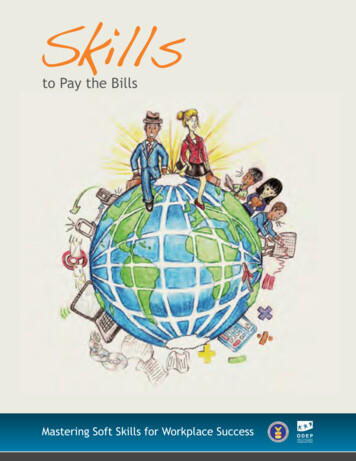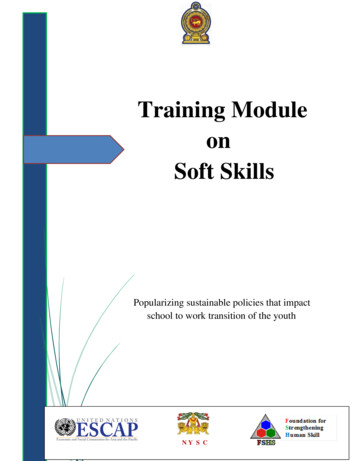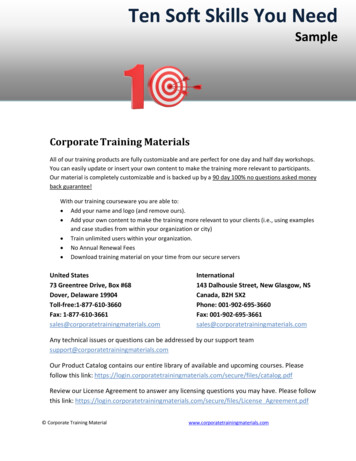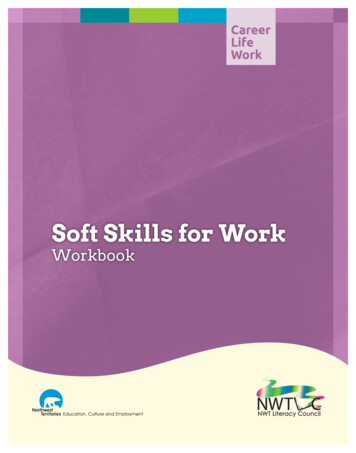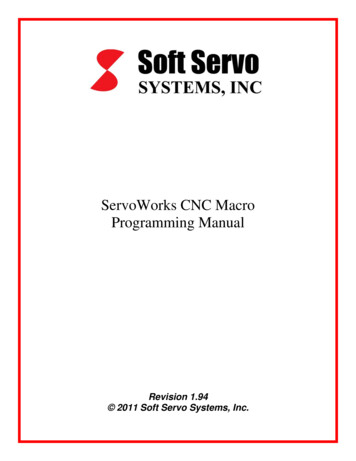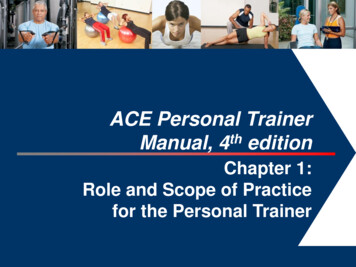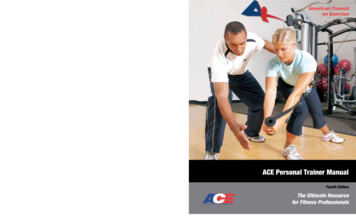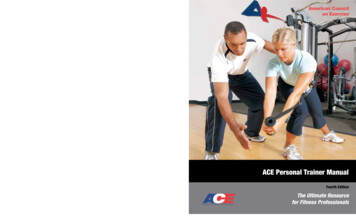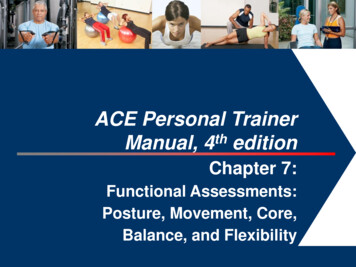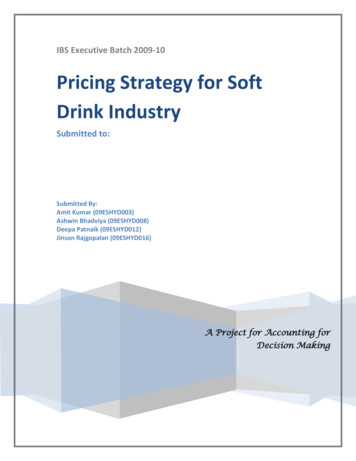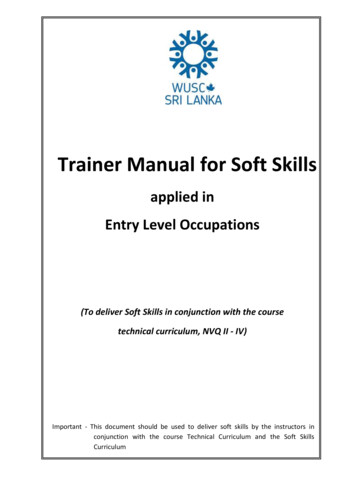
Transcription
Trainer Manual for Soft Skillsapplied inEntry Level Occupations(To deliver Soft Skills in conjunction with the coursetechnical curriculum, NVQ II - IV)Important - This document should be used to deliver soft skills by the instructors inconjunction with the course Technical Curriculum and the Soft SkillsCurriculum
tion4Module Numbers and Modules including Reference Material04M 01.Communication skills5-1205M 02.Team building & leadership13-1706M 03.Time management18-2307M 04.Personality, professionalism and work ethics24-3008M 05.Problem solving31-361
ForewordThe practical integration of Soft Skills into vocational training courses has proven to be difficult toconsistently achieve in the past. While private sector employers often compliment the technicalskills of trainees graduating from certified skills training courses, they have found graduatingtrainees’ employment related soft skills to be very poor.Given this, the Government of Canada funded WUSC ASSET project undertook an initiative todevelop soft skills modules for partner vocational training centers to integrate into training. This wasdone in close collaboration with industry/private sector employers and vocational training partners.A series of discussions with key stakeholders, including key government bodies, were held toformally develop the framework for a curriculum for Soft Skills and a Soft Skills Trainer Manualtargeting entry-level vocational training programs/trainees up to the National VocationalQualification (NVQ) Level 4.A Training of Trainers (TOT) program was conducted to train instructors attached to ASSET vocationaltraining providers on how to use the Soft Skills curriculum documents in conjunction with thetechnical curriculum of skills training courses. A practical approach for the delivery of soft skillstraining was promoted. The TOT program for instructors has now been piloted through two TOTprograms, one in Sinhala and one in Tamil medium.This curriculum comprises of five modules covering:1. Communication skills;2. Team building & leadership;3. Time management;4. Personality, professionalism and work ethics; and5. Problem solving.The Tertiary Vocational Education Commission (TVEC) has approved the modules and is nowincluding the module in NVQ Level 1 to 4 National Competency Standards. Piloting and testing inregistered vocational training institutions has been completed.We trust that this collaboration will enhance the quality of skills training programs in Sri Lanka andthat important soft skills will improve the employability of female and male youth entering the skilledlabour market in Sri Lanka.Yours truly,Doug GrahamCountry Director – WUSC Sri LankaWUSC – ASSET ProjectMarch 20192
AcknowledgementOverall DirectionMs. Esther M. McIntoshFormer Country Director, WUSC – ASSET ProjectMr. Doug GrahamCountry Director – WUSC Sri LankaWUSC – ASSET ProjectDeputy Program Director, WUSC – ASSET ProjectMr. Deepthi LamahewaTechnical SupportMr. S. U. K. Rubasinghe (Master Trainer), Director(NVQ, NCS & Curricula – TVEC)Mr. Sivasubramaniam Muguntthan,Vice President, Institution of ProfessionalDevelopment for Teachers (IPDT), JaffnaMr. D. M. Yahampath (Master Trainer), AssistantDirector (Staff Development), Vocational TrainingAuthority of Sri LankaMr. A. L. M. Imam (Master Trainer), VocationalTraining Authority of Sri LankaMr. C. R. Samaraweera, Freelancer (TVET Sector)Mr. W. Denzil Fernando, Manager Skills forEmployment, WUSC – ASSET ProjectFacilitator/CoordinatorMr. W. Denzil Fernando, Manager Skills forEmployment, WUSC – ASSET ProjectAdministrative SupportMs. Gowri Ravishanker, Senior Finance Manager,WUSC – ASSET Project3
IntroductionSoft skills are in high demand among private sector clients and youth themselves.During WUSC – ASSET final fiscal year, the soft skill packages used by differentpartners were reviewed and finalized a common content by having regional levelconsultative meeting to accommodate the requests made during meetings andprivate sector industries specific content. Based on the content of the soft skillscurriculum, this soft skills trainer manual was developed by a group of consultants.The training delivery package is consisted of the soft skills modules for each andevery soft skill area including this trainer’s manual, student activities and referencematerial developed. This soft skills trainer manual should be used in conjunctionwith the course technical curriculum and the soft skills curriculum to deliver softskills.The course instructor should identify the appropriate module/task no in thetechnical curriculum to match the topics given under the content pages of this SoftSkills Trainer Manual. He/she can follow the mode of delivery, activities andassessment guide given in this trainer manual. Instructor is free to choose anyadditional activities related to soft skills delivery to match the module/tasks in thetechnical curriculum.Instructors are advised to prepare a separate scheme of training (T2 form) for eachand every soft skills module. An awareness program or a TOT should be plannedand delivered under the guidance of TVEC by the respective officer in charge ofstaff training in the VT institutions.4
Soft Skills Trainer’s ManualModule No: 01Module Title: Communication SkillsImportance of the Module:The trainee has to communicate effectively and efficiently with the instructors and colleagues in thetraining centre and customers, supervisors and co-workers in the workplace.Effectivecommunication will improve the interpersonal relationship, productivity and minimize conflict. Youwill need to request information, discuss problems, give instructions, work in teams, and interactwith colleagues and clients. If you are to achieve co-operation and effective teamwork, good humanrelations skills are essential.Everything you do in the workplace, results from communication. Therefore good reading, writing,speaking and listening skills are essential if tasks are going to be completed and goals to be achieved.In following occasions in your career you will find various reasons why successful communicationskills are important. To secure an interview and get the jobTo do your job wellTo advance in your careerContentRef.noTopic1.Different types of Communicationo Verbal communication Oral communication Written communicationo Non-verbal communication2.Body language and platform skills3.Internet & e-mail communication4.Communication etiquettes5.Barriers to communication6.Effective listening skillso Types of listening7.Effective presentation8.Effective communication skillsAppropriate module/task no. in thetechnical curriculum5
Mode of delivery:This module will be delivered throughout the course as a supporting document for soft skillsdelivery and to be used along with the technical curriculum modules/tasks. After the eachactivity teacher has to give feedback based on above topics.Activities:1.2.3.4.Make a presentation by each students on subject matter learnt on rotational basisRequest student to maintain summarized weekly note bookFill forms related to work environment, make written request for leaveSearch related job vacancy in news papers/gazette/any electronic media and prepareapplication/CV5. Teacher has to give feedback and maintain students’ performance recordAssessment guide:When a task is assessed in the technical curriculum consider the performance of the trainee relatedto soft skills too. During the formative assessment instructor has to give feedback and maintainstudents’ performance record.Reference material/Supporting resources:CommunicationWhat is Communication?What does it mean to you?The process of communication is what allows us to interact with other people; without it, we would be unableto share knowledge or experiences with anything outside of ourselves. Common forms of communicationinclude speaking, writing, gestures, touch and broadcasting.Wikipedia definitionCommunication is a process of exchanging information, ideas, thoughts, feelings and emotions through speechsignals, writing or behavior. In communication process, a sender encodes a message and then using a mediumand sends it to appropriate feedback using a medium. Different types of communicationoVerbal/non-verbal communicationVerbal Vs Non VerbalCan we communicate without words?6
Voice attributesWhat are they and how do they affectcommunication?Physical attributesWhat could be considered here and how do they affect communication?The power of touchWhat and when is OK?Which is better, verbal or non verbal?Verbal CommunicationVerbal communication refers to the form of communication in which message is transmitted verbally,communication is done by words, mouth and a piece of writing. Objective of every communication is tohave people, understood what we are trying to convey.Parts of Verbal Communication - Oral or Written communicationIn oral communication, spoken words are used. It includes face-to-face conversations, speech,telephonic conversation, video, radio, television, voice over internet. In oral communication,communication is influence by pitch, volume, speed and clarity of speaking.In written communication, written signs or symbols are used to communicate. A written message maybe printed or hand written. In written communication message can be transmitted via email, letter,report, memo etc. Message in written communication, is influenced by the vocabulary & grammarused, writing style, precision and clarity of the language used.Non-Verbal Communication Through signs & symbols. Non-verbal can go without verbal communication. Verbal can’t go without non-verbal communication.Non-Verbal Communication is all aspects of communication other than words themselves. Itincludes how we utter words, features of environments that affect interactions and that influencepersonal images & interaction patterns.7
Body language and platform skillsBodylanguage isatypeofnonverbalcommunication in which physical behavior, as opposedto words, are used to express or convey information.Such behavior includes facial expressions, bodyposture, gestures, eye movement, touch and the use ofspace.o Facial ExpressionFace is the index of mind. Think how muchinformation can be conveyed with a smile ora frown. By facial expressions we can show orwe can understand happiness, sadness, angerand fear and much more.HeadIf someone moves his\her head up & down it means he\she is agree with you or saying yes and italso means understanding and acknowledgement. Sideways movement of head means no or notunderstood. If a person brings his head down and looking his feet or earths it is the symbol ofhumility & modesty.Eye GazeLooking at another person can indicatea range of emotions like anger, grudgeand danger, a dangerous look can tellyou someone is unhappy and notcomfortable with.Gestures & Postures8
Shape of BodyPersonal appearance adornment Appearancecanindicateourprofession It shows your nature, interest and yourtaste It can also point out our religious andcultural valuesHaptics (Touch language)Signs9
Platform skills are presentation behaviors that a trainer uses to transmit content effectively. Not to beconfused with skills that guarantee participation (which, in general, only trainers use), both presentersand trainers must demonstrate excellent platform skills to get their messages across.oInternet and email communicationWhat is email communication?Short for electronic mail, email (or e-mail) is defined as the transmission of messagesover communications networks. Typically the messages are notes entered from the keyboard orelectronic files stored on disk. Most mainframes, minicomputers, and computer networks havean email system.What is the Internet communication?Internet communication is referred to as the sharing of information, ideas, or simply words over theWorld Wide Web, or the Internet. The Internet consists of a worldwide string of connected networksthat exchanges data through packet switching using the standardized Internet Protocol Suite (TCP/IP). Communication etiquettesWorkplace communication etiquette involves commonly accepted norms and behaviors usedwhile communicating with others in the workplace. Some aspects of workplace etiquette relate tobasic standards of appropriateness when communicating with others.What you hearTone of voiceVocal clarityVerbal expressiveness40% of the message10
What you see or feelFacial expressionDress and groomingPostureEye contactTouchGesture50% of the messageWORDS 10% of the message!Barriers to communicationBarriers to Effective CommunicationLanguageTimeNoiseOther peopleDistractionsBarriers toeffectivecommunicationPut downsToo many questionsLack of interestDistanceDiscomfortwith the topic DisabilityEffective listening skillsThe Art of Listening“If we were supposed to talk more than listen, we would have been given two mouths and one ear.”Mark TwainListening SkillsActive ListeningRespondingInterpretingAsking questions for clarificationImitate the other person’s languageFor Teacher - Discuss what each of these means and give/ask for examples. Practise in pairs; Oneparticipant is given a situation/problem to talk about and the partner has to practise some of thelistening and responding skills. Practice is also attempted in Interpreting and clarifying.oTypes of listening Appreciative Listening - Listening to enjoy what you hear Informative Listening - Listening to gather information such as facts, directions, news, orinstructions11
Critical Listening - Listening to examine and evaluate the message for logic, truth, and value Empathetic Listening - Listening to another person’s feelings or thoughts, with the ability toput yourself in their shoes Precision Listening - Listening to single out one particular sound with exactness and clarity Discriminative Listening - Listening to distinguish between all the sounds in yourenvironment Social Listening - Listening with just enough effort to give a response Effective presentationTop Tips for Effective Presentationsooooooo Show your Passion and Connect with your Audience. It's hard to be relaxed and be yourself whenyou're nervous. .Focus on your Audience's Needs. .Keep it Simple: Concentrate on your Core Message. .Smile and Make Eye Contact with your Audience. .Start Strongly. .Remember the 10-20-30 Rule for Slideshows. .Tell Stories.Effective Communication:If someone achieves the desired level of objective through communication, we can say that it is“effective communication”.e.g. If your communication get the proper response from the receiver, it means that you effectivelyconveyed the message.Effective Communication SkillsEye contact & visible mouthSome questionsEncouragementto continueBody languageEffectiveCommunication skillsSilenceSmiling faceSummarisingwhat has been saidCheckingfor understandingFor Teacher - Encourage participants to think about a situation where they must communicate withsomeone who is hard of hearing; anxious; has been put down in the past; doesn’t know who you are –what are some of the things you can do to help communication12
Module No. 02Module Title: Team building and LeadershipImportance of the Module:The trainees has to work as a member/leader of a team in the training centre and in the work place.Teamwork helps to achieve organizational objectives by solving problems and giving synergy effect.So team work is essential part of a work place success.Employers look for people who know how to work well with others in the workplace. The ability towork as part of a team is one of the most important skills in today’s job market.Teamwork involves building relationships and working with other people using a number ofimportant skills and habits: Working cooperatively Contributing to groups with ideas, suggestions, and effort Communication (both giving and receiving) Sense of responsibility Healthy respect for different opinions, customs, and individual preferences Ability to participate in group decision-making When employees work together to accomplish agoal, everyone benefitsContentRef.noTopic1.What is team and team work.2.Importance of team work in the work environment3.Benefits and challenges4.Leadership traits and skills5.Key responsibilities of team leader and team members6.Role model of leadership7.Motivation for success8.Effective communication for success of team workCommunicate openly & supportivelyListen activelyInterpret nonverbal messagesGive useful feedbackReceive feedback effectivelyAppropriate module/task no. inthe technical curriculum/ extracurricula activities13
Mode of delivery:This module will be delivered throughout the course as supporting document for soft skillsdelivery and to be used along with the technical curriculum modules/tasks.Before start the Activity 3 and 4, instructor should provide brief introduction of expectedoutcome related to the soft skills applied. After completion of the activities instructor shouldhave a one hour discussion with teams related to the soft skills applied and provide feedback.Instructor should advise the team to make a report on given format base on the activityperformed.For other activities (1, 2 & 5) instructor should give feedback related to the soft skills appliedand developed.Activities1. Form different groups to perform tasks in the technical curriculum whenever possible2. Form groups for workshop cleaning, machine maintenance, gardening maintenance,waste management in training centre3. Organize sports activities / social and cultural events to develop team building andleadership4. Arrange open day /Exhibitions/blood donation camp5. Appointing class monitor on rotational basisAssessment guide:When a task is assessed in technical curriculum consider the performance of the soft skill too. Duringthe formative assessment instructor has to give feedback and maintain students performance recordReference material/Supporting resources.Team building and Leadership What is team and team work?ooA Team - a group of people workingtogether to achieve a common goalTeamwork - the ability to cooperate andcommunicate effectively with others toachieve a common goal T- - - - To g e t h e r E----Everyone A- - - - A c h i e v e s M----More3Copyright Texas Education Agency, 2015. All rights reserved. Importance of teamwork in present work environmento“To provide accurate information that would assist individuals in achieving a better quality oflife.”14
oo People working together can sustain the enthusiasm and lend support needed to completethe work of each programA Teams succeeds when its members have: a commitment to common objectives defined roles and responsibilities effective decision systems, communication and work procedures good personal relationshipsBenefits and challengesTeam WorkingBenefitsChallengesPromoting UnityLoss of EfficiencyPromoting Diverse ThinkingLack of Effective CommunicationMore Work in Less TimePersonality ConflictTEAMWORK Agree on goals / milestones Establish tasks to be completed Communicate / monitorprogress Solve problems Interpret results Agree completion of project Team Morale depends ono Supporto Resourceso Communicationo Personalities Leadership traits and skillsINDIVIDUAL WORK Work on tasksWork on new / revised tasksResearch / developmentNetworkingoBoss versus LeaderAre a boss and leader always the same?oSkills of Effective Leaders Building and sustaining relationships Developing and communicating a vision Influencing people Making decisions Overcoming setbacks and adversity Understanding people’s needsHave students discuss thedifference between someonewho just tells everyone whatdo to and someone whoinspires people do to theirbest, List characteristics ofeach.15
oCharacteristics of a Good Leader Challenge people to thinkCommunicate clear expectationsLead by exampleMake decisionsMake others feel safe to speak upMeasure and reward performanceProperly allocate and deploy talentProvide continuous feedback-positiveand negative Are accountable to othersAre great teachersAsk questions and seek counselCreate a positive, energeticatmosphereGenuinely enjoy responsibilityInvest in relationshipsProblem solve withoutprocrastinatingAre professional A good leader will possess the qualities as above. What qualities do youfeel is missing from the list? Allow for a short discussion. Key responsibilities of team leader and team membersoWhat is Teamwork & Team Building TeamworkConcept of people working together as a team Team playerA team player is someone who is able to get along with theircolleagues and work together in a cohesive group Team BuildingProcess of establishing and developing a greater sense of collaboration and trustbetween members Teamwork Skillso Listeno Questiono Persuadeo Respecto Helpo Shareo Participate Role model of leadershipooThink about the great leaders of our country or the world. What are some examples of howthey exhibit(ed) good leadership skills?Allow for a short discussion16
Motivation for success (How to achieve success)ooooooooo Responsibility –not blaming anythingHard work – ready to work in any timeCharacter – values, beliefs & personality of youRight time- ready to do at right timePersistence- failing also a step to successCreativity – excellence of his effortCommitment – winning edgeLearning - life long processPlanning - exactEffective communication for success of team workoooooCommunicate openly & supportivelyListen activelyInterpret nonverbal messagesGive useful feedbackReceive feedback effectivelyWhat is the difference between an effective team member and anineffective team member?Enrichment activity: Divide the class into groups. Give each group posterpaper and markers. Have groups develop a list of items that create asuccessful team and present their posters to the class. These could beplaced in the hall to share with the school.17
Module No. 03Module Title: Time ManagementImportance of the Module:It’s difficult to take control of every single minute of your day especially when there are too manydistractions around. Since childhood, our parents and teachers have advised us to spend time andmoney wisely. Good time management allows you to accomplish more in a shorter period of time,which leads to more free time, which lets you take advantage of learning opportunities, lowers yourstress, and helps you focus, which leads to more career success. Each benefit of timemanagement improves another aspect of your life.In the business world of today, time is increasingly at a premium. We spend time commuting towork, then filling up the workday before commuting home again and facing whatever time issues areposed when trying to fulfill our duties outside of the workplace. This increases the stress.ContentRef.noTopic1.Benefits of time management2.Obstacles to effective time management(Unclear objectives, disorganization,inability to say “no”, interruptions, periodof inactivityAppropriate module/task no. in thetechnical curriculum(To be filled by the Instructor)Strategies to overcome obstaclesSet goals(SMART)3.PrioritizeOrganize4.Use your waiting time5.Concentrate on the tasks at hand6.Celebrate your success7.Record, Analyze and Change (RAC) methodMode of delivery:This module will be delivered throughout the course as supporting document for soft skillsdelivery and to be used along with the technical curriculum modules/tasks. After the eachactivity teacher has to give feedback based in above topics.18
Activities Provide practices and technical assignments with time frame during the training periodAt the end of the 1st month of training each student has to prepare a plan for weekend Provide practices and technical assignments with time frame during the training periodactivities (All the activities including personal). 1st day after the weekend, analyze theactivities done according to then given plan and provide the feedback on RAC method.This should be continued for each weekend.Assessment guide:When a task is assessed in technical curriculum consider the performance of the soft skill too. Duringthe formative assessment instructor has to give feedback and maintain students performance recordReference material/Supporting resources.Time managementWhat you accomplish during a 24-hour period dependson your own motivation, your energy, your skills andabilities, and other resources.Since there are always demands on your time, it may behelpful to think about what you will do with your timeand to consider some strategies for more effective timemanagement.Time management is not a way to make you work harder and longer, but a means to help you work smarter toaccomplish your work more easily and rapidly. Benefits of time managementoooEfficientSuccessfulHealthyIf you can manage your time more effectively, you will be rewarded in a variety of ways: You will be more efficient in learning at the training centre or serving your company better You will achieve greater success as a trainee in your training centre or craftsman at your workplace On a personal level, you will certainly feel healthier, more energetic, and in a generally bettermood Obstacles to effective time management (Unclear objectives, disorganization, inability to say “no”,interruptions, period of inactivity)There are a lot of things that make it difficult for us to manage our time effectively. Let’s considersome of the most common ones, and see if they apply to us:19
ooooooooo Unclear objectives – It’s hard to hit a target with your eyes closed, and it’s just as hard toaccomplish something when you aren’t exactly clear about what you want to achieveDisorganization – It’s easy to see when your desk or work area is too messy, but sometimesyou have to step back and ask yourself if you are taking an organized approach in completingall of your tasksInability to say “no” – We all want to be as helpful as we can when others need us, but thiscan mean taking time away from other priorities to do something we may not have plannedInterruptions – Many times we are in the middle of accomplishing something really importantand the telephone rings. These calls can not only take you away from your task, butsometimes they interrupt your train of thought and you can’t return to where you werewithout retracing your stepsMore interruptions – We all like to visit with others, but conversations at inappropriate timescan cost us time when we have to stop what we are doing and redirect ourselves from ourplansPeriods of inactivity – As much as we think we are busy, there are times in our day when weare not really doing anything. Recognizing and making use of these times can have a positiveeffect on our effortsToo many things at once – Many of our tasks are not routines. They require concentration todetail. When we are attempting to do too many different things at one time, each individualtask suffers as a resultStress and fatigue – Everyone experiences stress from time to time, and sometimes weactually operate a little better when there is some level of stress. Too much stress, on theother hand, causes our work to suffer and wears us down physically and mentally. Dealingwith stress is an important part of time managementAll work and no play – Most successful people know how to balance work and play. Whenwork takes over your life, you not only give your body little time to re-energize, but you mayend up sacrificing the really important things in life like family and friendsStrategies to overcome obstaclesThe obstacles that we face are not impossible. Sometimes, the hardest thing to do is to identify thatthese obstacles exist and are affecting your ability to manage your timeWhen you have identified your obstacles you can begin to overcome themHere are some strategies you can use to overcome the obstacles we just examined:o Set goals (SMART) –The first and most important strategy you can employ to manage your time is to set clear goals foryourself. The best favor you can do for yourself is to determine what those goals are and makesure your efforts are always directed toward their achievement. Effective goals share a number ofcharacteristics in common. Effective goals are: Specific – When a goal is too vague, you may never know how to reach it or even when youhave reached it. Make sure that you know exactly what you hope to achieve Measurable – When you have a goal that is measurable, you will know how far you have to goto reach the goal, and when you get there Achievable – It is commendable to set your sights high, but sometimes we try to accomplishmore than we can actually do. Accomplishing a no of tasks in your work place in one20
day/week may or may not be achievable at this time for a number of reasons. Your goalsshould be such that, if you “extend yourself” you can just reach them. Realistic – Can you accomplish a no of tasks in a day/week, which is urgent & important? It iscertainly a worthwhile goal, but it may not be realistic at this time. It might be better to workon setting up a plan together with other co-workers to accomplish the tasks in given time. Time-based – Most of the goals that you establish in your position as a craftsman will not belong-term. It is important to set time guidelines for your goals, so that you can keep track ofyour progress as you are going along and can be alert to when you are falling behindschedule.o Prioritize – Do – Determine from the list the things you think are most important to accomplish, and arethings you should do yourself. Delegate – Remember that there many workers with skills, experience, and motivation tocarry out a wide variety of tasks. Delegating not only frees up your time for other things, itensures that resources are used wisely and that who want to help are motivated andinvolved. Delay until another time – Some things can wait. The danger is delaying too many things untildeadlines are near. The best policy h
The training delivery package is consisted of the soft skills modules for each and every soft skill area including this trainers manual, student activities and reference material developed. This soft skills trainer manual should be used in conjunction with the course technical curriculum and the soft skills curriculum to deliver soft skills.
